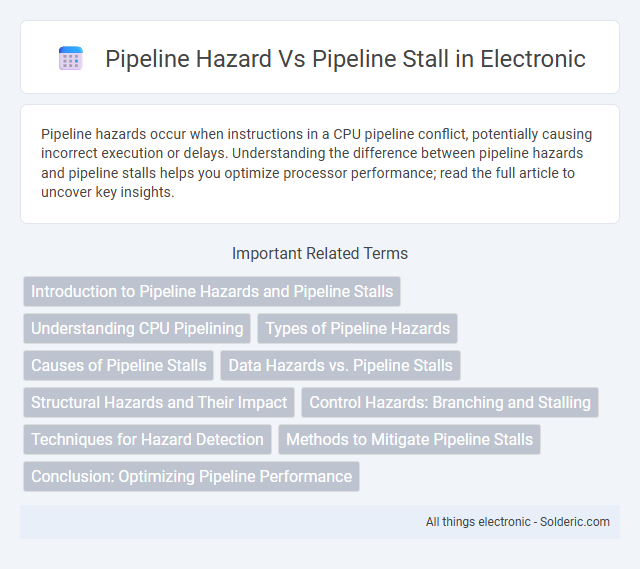Pipeline hazards occur when instructions in a CPU pipeline conflict, potentially causing incorrect execution or delays. Understanding the difference between pipeline hazards and pipeline stalls helps you optimize processor performance; read the full article to uncover key insights.
Comparison Table
| Aspect | Pipeline Hazard | Pipeline Stall |
|---|---|---|
| Definition | Conditions causing incorrect execution or conflicts in instruction pipeline stages. | Deliberate delay introduced to resolve pipeline hazards and ensure correct execution. |
| Cause | Data hazards, control hazards, structural hazards in pipeline processing. | Pipeline hazards that require pausing instruction flow to fix dependencies or resource conflicts. |
| Effect | Potential incorrect instruction execution or data inconsistency. | Increased instruction latency, reduced pipeline throughput. |
| Resolution | Handled by forwarding, hazard detection units, branch prediction. | Implemented by inserting NOPs or delaying instruction fetch and execution stages. |
| Nature | Problem or conflict in pipeline operation. | Technique or mechanism to manage hazards. |
| Impact on Performance | Direct source of pipeline inefficiency. | Contributes to pipeline performance penalty but prevents errors. |
Introduction to Pipeline Hazards and Pipeline Stalls
Pipeline hazards are conditions that disrupt the smooth execution of instruction sequences in a CPU pipeline, causing conflicts such as data, control, or structural hazards. Pipeline stalls occur when the pipeline control logic delays instruction processing to resolve these hazards, effectively pausing instruction flow to prevent errors. Understanding the relationship between pipeline hazards and stalls is crucial for optimizing processor performance and minimizing execution delays.
Understanding CPU Pipelining
Pipeline hazards occur in CPU pipelining when instructions conflict over resources, data, or control flow, leading to potential execution errors. A pipeline stall is a deliberate pause introduced to resolve these hazards by delaying instruction progress until the conflict clears. Efficient hazard detection and stall management are critical for maintaining optimal CPU throughput and minimizing performance degradation.
Types of Pipeline Hazards
Pipeline hazards can be classified into three primary types: data hazards, structural hazards, and control hazards. Data hazards occur when instructions depend on the results of previous instructions, leading to read-after-write conflicts. Structural hazards arise from hardware resource conflicts, while control hazards result from branch instructions disrupting the normal instruction flow, causing pipeline stalls.
Causes of Pipeline Stalls
Pipeline stalls are primarily caused by data hazards, control hazards, and structural hazards, which prevent the next instruction from executing in the pipeline. Data hazards occur when instructions depend on the results of previous instructions that have not yet completed, while control hazards arise from branch instructions disrupting the instruction flow. Structural hazards happen when hardware resources are insufficient to handle concurrent instructions, causing Your pipeline to stall until the resource becomes available.
Data Hazards vs. Pipeline Stalls
Data hazards occur when instructions that exhibit data dependencies overlap in a pipeline, causing incorrect data to be used during execution. Pipeline stalls are deliberate pauses introduced to resolve these hazards by delaying instruction processing until the hazard is cleared. Your system's performance can be optimized by minimizing stalls through techniques like forwarding or hazard detection units, which address data hazards efficiently.
Structural Hazards and Their Impact
Structural hazards arise when hardware resources required for multiple pipeline stages conflict, causing delays in instruction execution. These hazards lead to pipeline stalls, where Your processor must pause subsequent instruction issuance until the resource becomes available, reducing overall CPU throughput. Efficient pipeline design and resource allocation strategies are critical to minimizing structural hazards and maintaining high performance.
Control Hazards: Branching and Stalling
Control hazards occur in pipelined processors when branch instructions alter the flow of execution, causing uncertainty about which instruction to fetch next. Pipeline stalls, or bubbles, are introduced to handle these hazards by temporarily halting instruction fetch and execution until the correct branch target is determined. This stalling prevents incorrect instructions from entering the pipeline, maintaining program correctness but reducing instruction throughput.
Techniques for Hazard Detection
Pipeline hazard detection techniques include hardware-based methods like hazard detection units that monitor instruction dependencies and pipeline registers to identify data, control, or structural hazards. Stall insertion mechanisms, such as pipeline interlocks, prevent hazards by pausing instruction fetch or decode stages until dependencies clear. Advanced approaches use dynamic scheduling and scoreboarding to predict and resolve hazards without frequent stalls, optimizing pipeline throughput and minimizing performance loss.
Methods to Mitigate Pipeline Stalls
Pipeline stalls occur when hazards delay instruction execution, reducing CPU efficiency and throughput. Methods to mitigate pipeline stalls include forwarding (data hazard resolution), branch prediction (control hazard reduction), and pipeline interlocks that dynamically detect and delay instructions only when necessary. Implementing out-of-order execution and dynamic scheduling further minimizes stalls by allowing independent instructions to proceed without waiting for previous dependencies.
Conclusion: Optimizing Pipeline Performance
Pipeline hazard detection and mitigation are critical for optimizing pipeline performance by minimizing stalls that delay instruction execution. Effective strategies such as forwarding, hazard detection units, and dynamic scheduling reduce stalls caused by data, control, and structural hazards, enhancing throughput and CPU efficiency. Implementing advanced techniques like branch prediction and out-of-order execution further streamlines pipeline flow, ultimately maximizing performance in modern processors.
pipeline hazard vs pipeline stall Infographic

 solderic.com
solderic.com